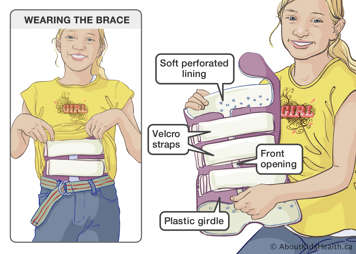What is a thoracic-lumbo-sacral orthosis?
A thoracic-lumbo-sacral orthosis (TLSO) is a body brace designed to halt the progression of scoliosis. The most common TLSOs are the Cheneau or Rigo System Cheneau style brace. A brace is worn over an undershirt to protect the skin.

Goal and requirements
- Goal: To have your child wear the TLSO for 20 to 22 hours per day after three weeks.
This means that your child needs to:
- put on their brace properly
- start wearing their brace gradually
- look after their skin
- clean their brace every day
For general information about spinal braces for scoliosis, please see Scoliosis: Treatment with a spinal brace (spinal orthosis). For more information on how your child can care for their brace, see Scoliosis: Caring for a spinal brace (orthosis).
Putting the TLSO on
The following steps can be performed by either you or your child once they are comfortable doing so:
-

To put the TLSO on, spread the brace at the bottom of the front opening. Slide the opening over one hip. Reach around the back and pull the rest of the brace around your child. Make sure all the straps are outside the plastic girdle.
-

Make sure the TLSO is not twisted and is facing straight ahead. The opening of the TLSO should be in the middle of your child’s front. The cut-out at the back should be centered on the crease between the buttocks. The waist roll of the TLSO (the indentations inside) should sit at your child’s waist, just above the hip bones.
-

Do up the middle Velcro strap first, then the bottom and top straps. As you do up the TLSO, you should be checking the positioning to ensure that the waist rolls are properly positioned.
-

At first, it may be easier to tighten the TLSO while your child is lying down. Their spine will be straighter and they will have more room to tighten the TLSO properly. Once your child gets used to the orthosis, they may be able to tighten it while standing up. Young children may need some assistance with tightening the straps, especially in the beginning.
Pull the extra cloth of the undershirt down around the bottom and top of the TLSO so that it is smooth. Make sure there are no wrinkles in the undershirt. Wrinkles can cause sores on your child’s skin.
-

Always do up the Velcro straps at the marked spots. If your child wears their TLSO loosely, they will have skin problems and discomfort, and the brace will not be effective. A loose TLSO will shift around each time they move and irritate their skin and prominent bones (ribs and hip bones). If your child experiences regular stomach bloating, they may slightly loosen the TLSO for a short time.
Getting used to wearing the TLSO
Getting comfortable using a TLSO is like getting used to new shoes. The following program is designed to help your child’s skin and muscles adjust to wearing the brace. It is a gradual build-up that usually takes two to three weeks.
You and your child should read the spinal brace daily wear schedule. Your child will follow 5 stages of brace wear, starting with six hours, then building up to eight, then 14, then 16 and finally 20 to 22 hours per day. This is simply a guide. Your child may make their own schedule as long as it is gradual and the brace is worn full-time (20-22 hours per day) after three weeks.
Have your child pin the spinal brace daily wear schedule to a bulletin board and check off each day as they complete it. If they fall behind, make sure they do not skip days. Ensure they keep following the schedule as closely as possible.
What to wear with a TLSO
Loose-fitting clothes will not reveal the outline of a TLSO. It is not unusual for your child to need to wear pants at least one size larger in order to accommodate the brace. Pants with elastic waistbands or drawstrings may fit more easily.
Physical activity
Brace wear tends to make muscles weaker, especially in the stomach and lower back area, so it is extremely important for your child to be as physically active as possible. They should participate in as many sports as they can.
Some sports such as baseball and bicycling may be done with the TLSO on. Other activities that need a lot of flexibility, like ballet, trampoline and gymnastics, may be more difficult to do with the TLSO.
Activities that require your child to correct their balance quickly or need increased flexibility or bigger breaths must be done with the TLSO off. These include:
- skating
- snowboarding
- downhill skiing
- horseback riding
When the TLSO is removed for sports, it is considered hours out of the brace. If your child spends more than two hours out of their brace, have them continue with their daily wear schedule as closely as possible.
Generally, your child may swim without their TLSO since the water will support their back. Check with your child’s doctor for specific instructions about swimming and other activities.
Cost of a TLSO
If your child lives in Ontario and has a valid Ontario health card, 75% of your child’s spinal brace will be paid for by the Assistive Devices Program (ADP). The remaining 25% is the responsibility of the family. Many private insurance companies cover some or all of the remaining cost. If you need help paying for your child’s brace, visit our reception desk for a list of charitable organizations that may assist you. Please visit or contact The Children's Orthotics Clinic for further information on pricing.